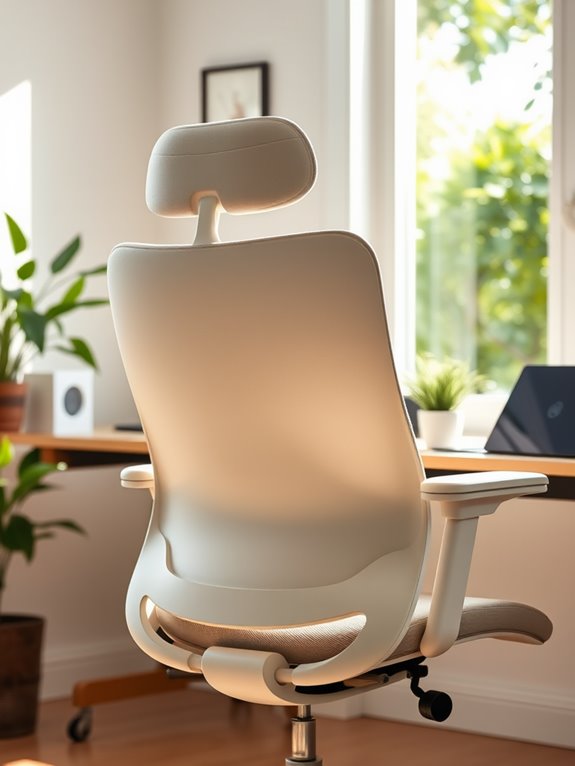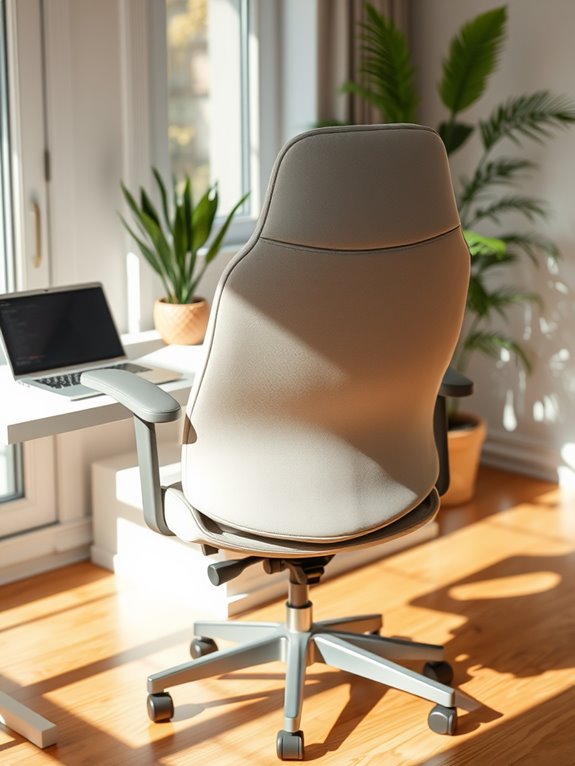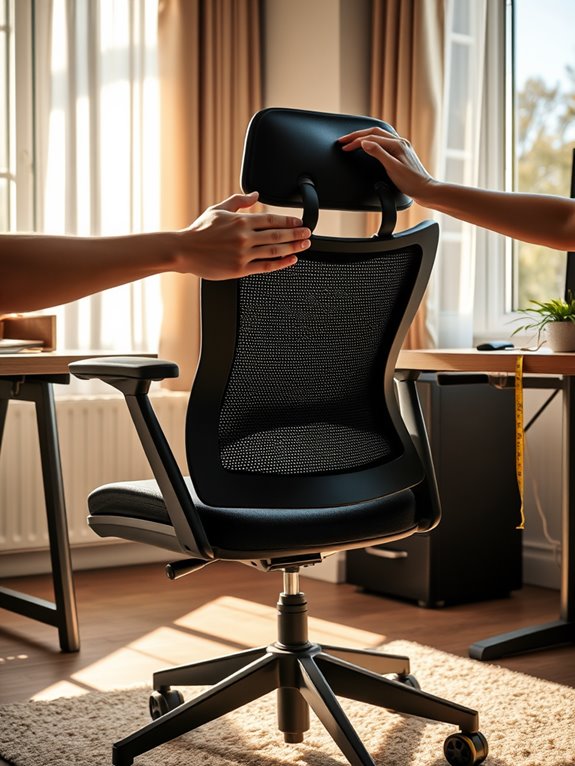To choose the right ergonomic chair for remote work, focus on adjustable lumbar support, seat height, and material quality for comfort during long hours. Look for features like breathable mesh fabric to keep cool and armrests that support natural alignment. Assess your workspace for layout and mobility needs to guarantee a good fit. Test the chair by adjusting settings and sitting for a while to find the most comfortable configuration. Discover more tips to optimize your workspace setup.
Nomad Highlights
- Assess your workspace dimensions to ensure the chair fits comfortably with your desk height and layout.
- Look for adjustable lumbar support to maintain your spine’s natural curve and reduce strain during long hours of sitting.
- Choose a chair with breathable materials to enhance comfort and airflow, preventing overheating during extended work sessions.
- Ensure the chair has adjustable height and armrests to accommodate your body type and promote an ergonomic posture.
- Test the chair for comfort by sitting in it for 15-20 minutes, adjusting settings based on any pressure points or discomfort experienced.
Understanding Ergonomics and Its Importance

Ergonomics, the science of designing workspaces that fit the user’s needs, plays an essential role in enhancing both comfort and productivity, especially when working remotely. Understanding its principles can greatly improve your daily work experience.
By focusing on ergonomic benefits, you can create an environment that fosters better posture correction and reduces strain on your body. When you sit in an ergonomically designed chair, it supports your spine’s natural curve, allowing you to maintain proper alignment. This alignment not only minimizes discomfort but also boosts concentration and efficiency. Additionally, prioritizing adjustable features in your chair can further enhance personalized comfort and support. Using products like lumbar support cushions can also provide extra back support, ensuring you maintain a healthy posture throughout the day. An ideal ergonomic chair should also feature breathable mesh fabric to promote airflow, keeping you cool during long working hours. Incorporating an adjustable footrest can further enhance your ergonomic setup by improving circulation and reducing discomfort in your legs. Furthermore, understanding the importance of proper fit in ergonomic designs can significantly enhance your overall comfort and productivity while working remotely.
Key Features to Look for in an Ergonomic Chair

When selecting an ergonomic chair, knowing which features contribute to ideal comfort and support can make all the difference in your remote work setup.
Look for an adjustable lumbar support system that conforms to your spine’s natural curve, reducing strain during long hours. This feature allows you to customize the chair to your body’s unique shape, enhancing comfort. Additionally, adjustable height options can significantly improve your posture while sitting for extended periods. A well-designed chair should also have premium materials that ensure durability and support for regular use. Ergonomic chairs that prioritize cushioned grips can further enhance your overall comfort during long working hours.
Additionally, pay attention to the seat depth; it should accommodate your legs without cutting off circulation. A seat that’s too deep can lead to discomfort, while one that’s too shallow may not provide adequate support. Investing in ergonomic benefits such as proper lumbar support and seat depth contributes to a healthier workspace overall.
Types of Ergonomic Chairs Available

A wide range of ergonomic chairs is available to suit different preferences and work environments.
For instance, mesh chairs offer excellent breathability, keeping you cool during long hours. They’re designed to conform to your body, providing tailored lumbar support that promotes proper posture and reduces back strain. Regular use of ergonomic furniture can greatly enhance overall comfort and productivity. Additionally, selecting a chair with durability and material is essential for long-term use and support. Many ergonomic chairs also feature adjustable resistance settings that allow users to optimize their seating experience according to their comfort preferences. Choosing models with stability and durability ensures that your chair can withstand daily use without compromising support.
Another popular option includes the more traditional padded chairs, which often come with adjustable features for height and tilt, ensuring comfort throughout your workday.
Traditional padded chairs offer adjustable height and tilt features, ensuring optimal comfort during your workday.
If you’re seeking versatility, look into executive chairs that blend style with functionality, often featuring enhanced lumbar support for prolonged use. Additionally, consider adjustable fit and comfort as a key factor in selecting the right chair, as it can significantly impact your overall work experience.
Ultimately, the right chair depends on your specific needs, so consider how each type aligns with your work habits and preferences.
Assessing Your Workspace Needs

To find the perfect ergonomic chair, it’s important to assess your workspace needs. Start by evaluating your workspace layout; measure your desk height and the space available around you. Consider how often you move or shift positions throughout the day—this will inform the chair’s mobility features. Additionally, a chair with ergonomic designs can significantly enhance comfort during prolonged working hours. The right chair can also help prevent wrist pain, which is essential for maintaining comfort during long stretches of work. Furthermore, a chair that complements your workspace can improve overall productivity in home office settings. It’s also beneficial to choose a chair that supports all-day activity tracking, as staying active throughout the day can enhance overall well-being. Next, think about chair materials; breathable fabrics can enhance comfort during long hours, while durable options guarantee longevity. Additionally, choose a chair with adjustable features to accommodate your unique posture and preferences. If you use multiple devices, prioritize a chair that supports your arms and neck effectively to reduce strain.
Testing and Adjusting Your Chair for Optimal Comfort

While you may have chosen the right ergonomic chair, ensuring it fits your body perfectly requires careful testing and adjustment.
Begin with chair adjustments; adjust the height so your feet rest flat on the floor and your knees are at a 90-degree angle.
Next, focus on the backrest. It should support your lower back, allowing your spine to maintain its natural curve. Incorporating adjustable height settings for your workspace can enhance comfort and reduce strain. Additionally, ensuring you have a compact foam roller on hand can help relieve muscle tension during long sitting sessions. Using a collapsible foam roller can provide convenient relief from muscle soreness, especially after extended periods of sitting. Remember, just like with compact massage guns, finding the right pressure and intensity is crucial for effective relief.
During comfort testing, spend at least 15-20 minutes sitting to identify pressure points or discomfort.
Don’t forget to adjust armrests—they should allow your arms to rest comfortably without lifting your shoulders.
Finally, make incremental changes and reassess how each adjustment affects your comfort. This personalized approach is key to creating a workspace that promotes productivity and well-being. Additionally, it’s beneficial to incorporate regular movement breaks and utilize tools such as compact foam rollers to alleviate muscle tension during long periods of sitting.
Frequently Asked Questions
What Is the Average Lifespan of an Ergonomic Chair?
The average lifespan of an ergonomic chair typically ranges from 7 to 15 years, depending on chair durability and usage frequency.
Investing in a high-quality ergonomic chair pays off long-term, as it can enhance your comfort and productivity.
When selecting your chair, consider its materials and construction, which directly impact durability.
A well-made chair not only supports your posture but also withstands daily wear, making it a smart ergonomic investment.
Can I Find Ergonomic Chairs on a Budget?
Absolutely, you can find ergonomic chairs on a budget!
Start by exploring affordable brands that prioritize comfort and support without breaking the bank. Look for budget options that offer adjustable features, such as seat height and lumbar support.
Check online reviews and comparisons to guarantee you’re making a smart choice. Investing in a well-designed chair can enhance your productivity, so don’t overlook the balance between cost and ergonomic benefits.
How Do I Clean and Maintain My Ergonomic Chair?
Think of your ergonomic chair as a trusty steed, needing care to keep it galloping smoothly.
To maintain your chair, employ gentle cleaning methods like a damp cloth for fabric and a mild cleaner for hard surfaces.
Regularly check and tighten screws to prevent wobbling.
Don’t forget to adjust the settings, ensuring they align with your comfort.
With consistent chair maintenance, you’ll extend its lifespan and enhance your workspace experience.
Are There Ergonomic Chairs Designed Specifically for Short or Tall Individuals?
Yes, there are ergonomic chairs designed specifically for short and tall individuals.
When you’re choosing one, look for adjustable features like seat height, armrests, and lumbar support to guarantee a comfortable fit.
For short individuals, a chair with a lower seat height and shorter backrest works best, while tall individuals benefit from a higher seat and extended backrest.
Prioritizing these adjustments helps maintain proper posture, enhancing productivity and comfort throughout your workday.
What Materials Are Best for an Ergonomic Chair?
When selecting materials for an ergonomic chair, consider options like mesh fabric and memory foam.
Mesh fabric promotes breathability, keeping you cool during long hours, while memory foam molds to your body, providing tailored support.
Look for chairs that combine these materials for ideal comfort and durability.
This innovative blend enhances posture, reduces strain, and improves your overall work experience, allowing you to focus without distractions from discomfort.
Conclusion
Choosing the right ergonomic chair isn’t just about comfort; it can greatly impact your productivity and well-being. Did you know that over 80% of remote workers experience discomfort due to improper seating? By investing in an ergonomic chair tailored to your needs, you can enhance your work experience and reduce the risk of chronic pain. Prioritize your health and productivity by making a thoughtful choice—after all, a well-supported body leads to a more focused mind.




